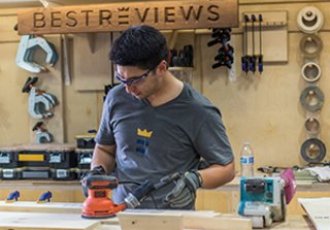We recommend these products based on an intensive research process that's designed to cut through the noise and find the top products in this space. Guided by experts, we spend hours looking into the factors that matter, to bring you these selections.

There's a limit to how big a hole you can drill with a standard bit. The solution for something bigger in most cases is a hole saw – which can be as large as six inches in diameter.
Different types of hole saws can cut through just about every material you can think of: drywall, wood, plastic, glass, tile, concrete, marble, and steel. They are a valuable addition to every tool kit, whether you are a weekend DIYer or a professional tradesperson.
Given the versatility, it's no surprise that there are lots of hole saw sets to choose from.

Most hole saws are comprised of an arbor, a metal cup with a toothed edge, and a pilot drill. The metal cup usually has straight sides – which makes it easier to cut a parallel hole – though some have sloped sides, which reduces friction or any chance of them binding in thick material. Not all models have a pilot drill, but it's usually included because without it, the hole saw has a tendency to wander – making it difficult to position accurately.
There is another tool called a hole saw, though more accurately it ought to be called a hole cutter. This consists of a bar with a cutting blade at one end and a shank to fit a drill chuck. As the drill rotates, the cutting blade cuts a circle. The main advantage of this type is that the blade can slide along the bar, making it adjustable. The disadvantage is that it has quite limited depth, and can only cut drywall, plywood and similar thin sheets.
What the hole saw is made of will define the materials it can cut through.
Inexpensive: Basic hole saw sets of high carbon steel (HCS) for cutting wallboard or pine paneling can be found for between $15 and $20. You'll find basic metal-cutting HSS hole saw sets for a similar price, but consider spending $10 to $15 more for TCT versions. Entry-level diamond hole saw sets don't cost any more than HCS versions – though depths will be limited, and the range of cuttable materials may be restricted.
Mid-range: Good bi-metal hole saw sets are in the $50 to $90 range, for which you'll get 12 to 15 sizes.
Expensive: A boxed set of heavy-duty diamond saws from a premium brand can be $200 or more, and you might get 8 or 10 sizes.
The main takeaway here is that there's something for every budget – but it pays to buy quality. Better to buy three of four really good pieces than a cheap set of 12, half of which you may never use.

Q: Should any special safety precautions be taken when using a hole saw?
A: As when using any power tool, always wear eye protection. Hole saws can produce a considerable amount of dust and airborne debris, so a lightweight breathing mask is a good idea.
When the cutting edge of the hole saw itself makes contact, there can be a noticeable torque reaction that can cause the drill to twist in your hands. Make sure you have a firm grip, and wherever possible keep the cutting edge level with the work surface.
If you're working with a corded drill and using water as a coolant, make sure the drill is connected to a GFCI (ground fault circuit interrupter) to prevent electric shock.
Q: Can I use hole saws with any type of drill?
A: You can, but you need to consider the material you are drilling and the size of the hole. A one-inch hole in plywood shouldn't present any problems for a DIY-type cordless drill. A two-inch hole in concrete is a very different proposition. If you have lots of heavy-duty work in hard materials, a powerful Slotted Drive System SDS drill is the obvious choice.
Bear in mind whatever the drill, you should only use rotary, not hammer action. A hole saw is not designed to cut that way, and you'll very likely damage it and possibly deform the hole, too.
Q: What's the difference between an annular cutter and a hole saw?
A: In essence, all hole saws are a type of annular cutter in that they are a ring shape with teeth or cutting material on the edge. Machine tool annular cutters have a much thicker cutting edge and no pilot drill. They are designed for precision engineering work and normally used in lathes or milling machines.
Get emails you’ll love.
Learn about the products you’re wondering if you should buy and get advice on using your latest purchases.
